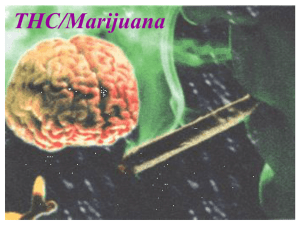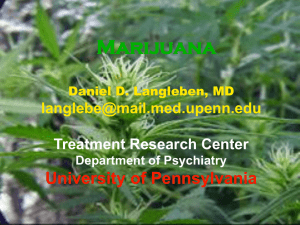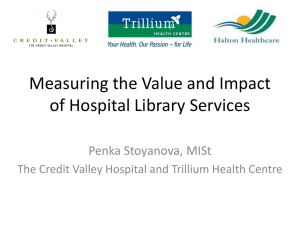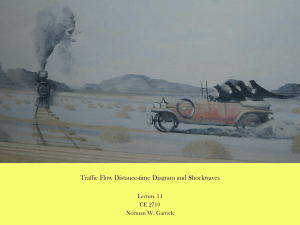to Prof Parolaro
advertisement
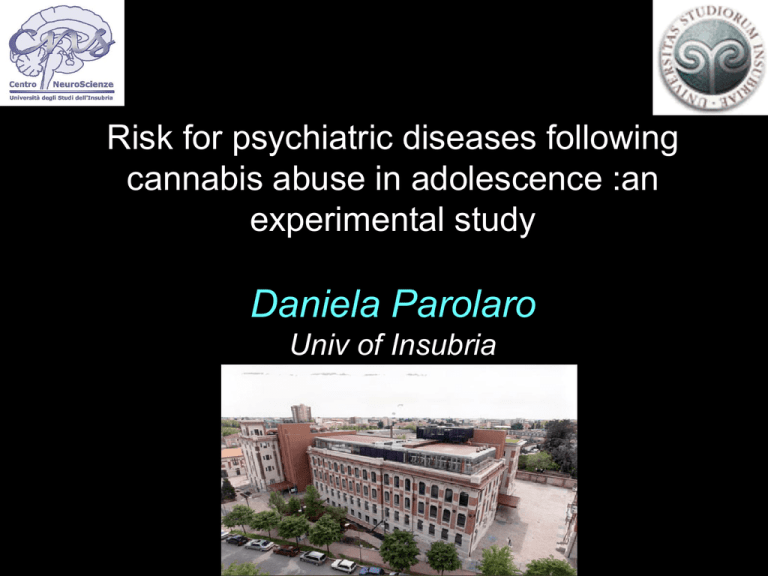
Risk for psychiatric diseases following cannabis abuse in adolescence :an experimental study Daniela Parolaro Univ of Insubria Characterization of the phenotype present in adult rats pre-exposed to THC in adolescence Arrival of animals Postnatal day (PND) 28 Beginning of treatment End of treatment 35 36 37 38 39 40 41 42 2.5 mg/kg 5 mg/kg THC THC Twice a day Twice a day 43 44 10 mg/kg THC Twice a day Beginning of behavioral tests 75 45 DRUG-FREE Adolescent THC exposure induced… No alteration in anxiety behaviour No presence of behavioural despair Spatial working memory impairments in the radial maze reduced markers of neuronal plasticity in the hippocampus changes in dendritic morphology and spine density in dentate granule cells of the hippocampus Rubino et al., Neuropsychopharmacol 2008; Hippocampus 2009 Adult THC exposure did not induce cognitive impairment in the radial maze alteration in markers of neural plasticity in the hippocampus COGNITION Novel Object Recognition Test Classic Spatial 50 50 vehicle+vehicle THC+vehicle vehicle+PCP * 0 * -25 Discrimination Index Discrimination index 25 25 0 -25 ** -50 -50 ** EMOTIONALITY Social Interaction Test Habituation phase (10 min) Test phase (10 min) 90 80 70 60 50 40 30 20 10 0 Aggressive behaviors 6 *** *** veh+veh THC+veh veh+PCP number of episodes time (s) Active social behaviors 4 2 0 veh+veh THC+veh veh+PCP EMOTIONALITY Forced Swim Test Single session 15 minutes - Immobility - Climbing - Swimming Immobility ** 350 ** 300 Swimming Climbing 700 200 100 600 150 80 100 50 time (s) 500 time (s) time(s) 250 400 300 60 40 200 20 100 0 veh+veh THC+veh veh+PCP 0 0 veh+veh THC+veh veh+PCP veh+veh THC+veh veh+PCP Anhedonia a b 100 vehicle THC % sucrose preference Palatable food (g) 0.8 0.6 0.4 0.2 90 80 * * 2 3 70 0.0 1 2 3 4 Days 60 0 1 Day Anhedonia through Fonzies intake Anhedonia through sucrose preference n. of photocell beam breaks PCP 2.5 mg/kg 4000 Locomotor activity ^^^ °°° *** ^^^ °°° *** 3000 ^^^ °°° *** 2000 1000 0 10 20 30 40 50 Time (min) 250 Stereotypies Time (sec) °°° ^^^ *** °°° ^^^ *** 200 150 ^^^ *** 100 °°° ^^^ *** ^^^ *** ^^^ *** ^ ° * 50 veh THC PCP THC+PCP ^ * °° ^^^ *** 0 10 20 30 40 50 Time (min) ONLY THC-TREATED RATS SHOW HYPERLOCOMOTION AND INCREASED STEREOTYPED BEHAVIORS IN RESPONSE TO A LOW DOSE OF PCP COMPARED TO CONTROL ANIMALS Adolescent THC exposure in female rats induces cognitive deficit, social withdrawal, avolition, anhedonia and sensitizes to PCP The hypersensitivity to PCP seems to be due to increased neuronal activation in the caudate putamen and nucleus accumbens as confirmed by enhanced glutamate release in the dorsal striatum Adult female rats exposed to THC did not show altered phenotype a b 100 Time (s) vehicle THC 150 * 75 c d % sucrose preference 225 90 80 70 e Vehicle THC 60 1 0 swimming climbing 2 Days immobility Realini et al 2010 3 Adolescent THC exposure led to decreased GAD 67 levels in adulthood paralleled by decreased basal GABA release in the prefrontal cortex GAD67 LEVELS *** control THC *** 2.0 *** 1.5 1.0 0.5 Basal extracellular GABA levels (nM) 10 2.5 Arbitrary Units (GAD67/ act) BASAL GABA RELEASE 8 6 4 2 0.0 46 PND 60 PND 75 PND 0 control THC Protein levels THC GluN2B- GluA1containing containing GluN2A- GluA2containing containing GluN2A- GluA2containing containing GluN2B- GluA1containing containing DEVELOPMENT ADOLESCENT THC EXPOSURE ALTERS THE REARRANGEMENT OF NMDA AND AMPA RECEPTOR SUBUNITS, RESULTING IN THE PRESENCE OF IMMATURE, MORE EXCITABLE, GLUTAMATERGIC SYNAPSES IN THE ADULT PFC Adolescent THC exposure decreased spine density at the distal portion of basilar dendrites DISTAL DENDRITES 10 spines/10m 8 6 * 4 *** *** 60 PND 75 PND 2 0 46 PND the brain continues to develop throughout adolescence important structural and functional changes in synaptic plasticity and neural connectivity At cellular level, changes in gray matter volumes appear to be associated with pruning in later adolescence Endocannabinoids as retrograde messengers THC ECS Adolescent brain lasting changes in brain and behavior? The endocannabinoid system undergoes maturational events during adolescence that are impaired by chronic THC exposure correct neuronal refinement peculiar of the adolescent brain altered brain functionality and behavior at adulthood The possible problems associated with marijuana consumption in adolescence suggest that the adolescence developmental phase represents a vulnerable time period for persistent effects on synaptic plasticity that could underline adverse actions of cannabinoids in adulthood.These effects are sex-dependent. Daniela.parolaro@uninsubria.it


